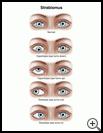
Eyes Point in Different Directions (Strabismus)
________________________________________________________________________
KEY POINTS
- Strabismus is a condition in which your eyes point in different directions.
- Treatment depends on the cause and may include glasses, eye exercises, medicine, or surgery.
________________________________________________________________________
What is strabismus?
Strabismus is a condition in which your eyes point in different directions. Usually one eye is pointed straight ahead and the other is pointed in a different direction.
Some common terms for strabismus are "cross eyed," which means that one or both eyes turn toward your nose or "wall eyed," which means one or both eyes turn out toward your ears.
What is the cause?
There are 6 muscles that work together to move each eye. Strabismus can happen when those muscles do not work together. This may be caused by a problem with the muscles around your eye, your nerves, or a problem in your brain. When your eyes do not work together to look at an object, your brain may cause you to see double. Your brain may pay attention to the image from one eye and ignore the image from the other eye. Over time you may not be able to see as well out of one eye.
Most people with strabismus are born with it and it tends to run in families. Strabismus may also be caused by:
- Eye or head injuries
- Stroke and other blood vessel problems
- Diseases that affect the nerves or muscles such as cerebral palsy, Down syndrome, multiple sclerosis, myasthenia gravis, or diabetes
- Thyroid disease, which causes swelling of the muscles, fat, and soft tissue around and behind your eye and can make your eye push forward
Sometimes the cause of strabismus is unknown.
What are the symptoms?
Symptoms may happen all the time, or only when you are tired or sick. Symptoms may include:
- Eyes turned in different directions
- Double vision
- Shutting one eye in outdoor light or squinting one or both eyes
How is it diagnosed?
Your healthcare provider will test your vision and ability to follow objects with each eye. Your provider will test if your eyes can work well together by checking for three-dimensional vision. He or she will also examine your eyes for any signs of disease.
How is it treated?
Treatment may include:
- Glasses, possibly with prism lenses.
- Eye exercises. These exercises train your eyes to move together and focus on the same object at the same time. Most forms of strabismus do not improve with eye exercises.
- Injections. If an overactive eye muscle is the cause of the strabismus, small amounts of botulinum toxin A can be injected into the muscles near the eye. This may weaken or stop the muscles on one side and allow the muscles on the other side to work harder. The shots can last several months and may even cause a permanent change.
- Surgery on your eye muscles. Muscles may be loosened, tightened, or repositioned. Strabismus surgery is not cosmetic surgery. Having eyes that are not aligned normally interferes with your ability to communicate with others through eye contact.
More than one surgery may be needed. The success of surgery depends partly on the coordination between your eyes and brain. It needs to be good enough to keep your eyes focused on objects and working together.
How can I take care of myself?
Follow the full course of treatment your healthcare provider prescribes. Ask your healthcare provider:
- How and when you will get your test results
- How long it will take to recover
- If there are activities you should avoid and when you can return to your normal activities
- How to take care of yourself at home
- What symptoms or problems you should watch for and what to do if you have them
Make sure you know when you should come back for a checkup. Keep all appointments for provider visits or tests.

